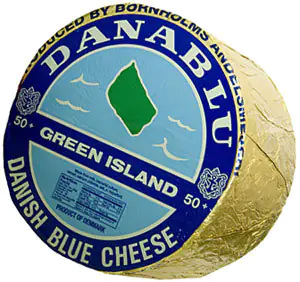Danablu (originally Danablu) is another semi-hard blue cheese, but this time of Danish origin. It was invented as a substitute instead of the well-known French Roquefort, only with a change in the preparation recipe by replacing sheep's milk with cow's milk. However, after some time, this product found its fans and gained equally popular positions throughout Europe. Multiple manufacturers of this product are located in different countries, and the cheese has a second name, Danish Blue. After that, in 1922, this Danish brand was awarded Protected Geographical Indication, which means a certificate of protected geographical origin. According to its name, Danablu belongs only to those cheeses that are produced in Denmark.
The first production of this product was mastered in 1915 on the island of Funen, which belongs to Denmark. This was not the first brand with mold produced at that time. Therefore, in order to achieve a more successful result, the recipe for the new product was carefully thought out for about ten years. The final version was ready only by the end of the thirties. By that time, manufacturers had already decided on the composition, fat content of milk, and the type of introduction of mold fungus into the cheese mass.
The fat content of this Dane is quite high - about 50%. It is for this reason that most famous bodybuilders try to exclude it from their daily diet. If you are seriously involved in bodybuilding or fitness, we recommend that you still refrain from this product and better turn your attention to other alternative brands.
Danablu is produced only from natural ingredients: milk, noble mold, lactic acid starter, rennet, salt. Mold requires a lot of oxygen to spread evenly. To do this, manufacturers make holes in the cheese wheel using certain steel rods. As soon as the mold grows through the entire mass and becomes noticeable on the rind, the cheese is ready to eat. Typically this process takes at least a month. After this, the last stage of preparation is washing and drying the cheese wheels. When preparing the product, not only mold is used, but also a large amount of salt. All this gives Danable a delicate and at the same time sharp, tart taste.
Post Views: 118


